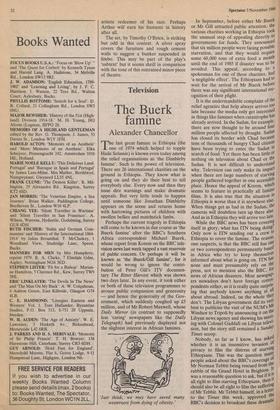Theatre
End of the line
Christopher Edwards
Tramway Road (Lyric, Hammersmith) rr he 'Road' in question runs through a .1 suburb of Capetown where, until they were evicted in 1961, the coloured descen- dants of tram drivers used to live. Ronald Harwood's new play is set in 1951 and although we never actually see Tramway Road we hear the sounds of menace, drunkenness and hopeless despair that rise up as soon as dusk falls on the predomi- nantly white residential area. The noises of Tramway Road act as a sort of choric soundtrack against which the play's action is set. That action takes place in a lending library run by Arthur and Dora Langley, a middle-aged couple who, with a shadowy past, have left England to live a life of mediocrity and quiet despair 6,000 miles (as Dora repeatedly states) from the centre of civilisation, i.e. London. In fact, while they have the fruits of that civilisation on their bookshelves, what they actually miss most keenly are the Central Line, Earls Court and the Sunday papers.
. Harwood is concerned with the race laws of South Africa, but his tone happily avoids the stern moralising of, say, Athol Fugard's Master Harold, a play which immediately comes to mind as another recent study of apartheid and betrayal. As in most theatre of conscience, the play- wright's moral position is never in doubt, but whereas Fugard lectured us at the expense of character, Harwood allows the atmosphere of cant and cowardice to build up through what is said and done, and when we are invited to pass judgment it is principally upon Arthur as an individual, and only obliquely upon the system.
Arthur is a teacher of elocution and drama, a believer in the supremacy of art over everything, and a lover of young boys although his affairs appear to be strictly of the sentimental variety. His latest prodigy is Emil (Richard E. Grant) whom we meet as the curtain rises, practising his vowels and pinning his hopes on a travel scho- larship to attend drama school in London. Arthur (Freddie Jones) treats Emil to his own fantasies of frustrated artistic achieve- ment, and, with all the comic self- importance of a tiny talent, claims the right to a footnote in Emil's biography when he becomes a great artiste. Freddie Jones excels at this sort of absurd, overblown effusion which he succeeds in making touching. Above all, he convinces us that Arthur is an enthusiast and actually be- lieves in the secondhand credo he solemnly intones to Emil. 'All great art redeems,' Arthur says, and more importantly, 'I believe in the talent-bar not the colour- bar.' This last idea is the key to the piece, and leads to the unexpected climax at the end of Act One. It is a climax which Harwood engineers cleverly. Emil is sub- ject to the disapproval of Annette Cros- bie's brittle, boozy Dora because, apart froth being jealous of her husband's crushes, she knows that they always cause grief. Interspersed with these comments are various stock denigrations of the blacks including their stupidity and their malodor- ousness. At the end of the act Arthur, sensing that Emil wants to confide in him, ushers him to the brink of what we expect to be a confession of homosexual inclina- tions. Instead, Emil dons the monkey- mask with which he and Arthur have been practising improvisation and, with appropriate ape-like gestures, confesses that he is to be reclassified as a coloured, and crashes out of the door to join his father down in Tramway Road. It sounds a rather stagy touch, but it comes as a complete surprise and works.
The second act never really recovers from this climax. We see Arthur in his true colours as a hypocrite; after tea at the Waldorf he tells Emil their friendship is over and comes back to the library to spend the rest of the play getting drunk with his wife. Freddie Jones earns the histrionic licence to make large, insincere declarations that add up to nothing more than self-pity and fudge: 'I am drained by a monumental sense of loss,' and his wife punctures all of this with frequent expres- sions of disgust at his baseness. But, while never exactly tedious, there is a falling away of tension and interest which is only momentarily retrieved by the passing of the 'Coon Carnival' beneath their window. Arthur, recovering his spark, talks of rhythm, spontaneity and life and wonders whether Emil should not now become the artistic redeemer of his race. Perhaps Arthur will earn his footnote in history after all.
The set, by Timothy O'Brien, is striking but odd in this context. A silver spray covers the furniture and rough cement walls to suggest a bunker suspended in limbo. This may be part of the play's 'subtext' but it seems shrill in comparison with the tone of this restrained minor piece of theatre.











































 Previous page
Previous page